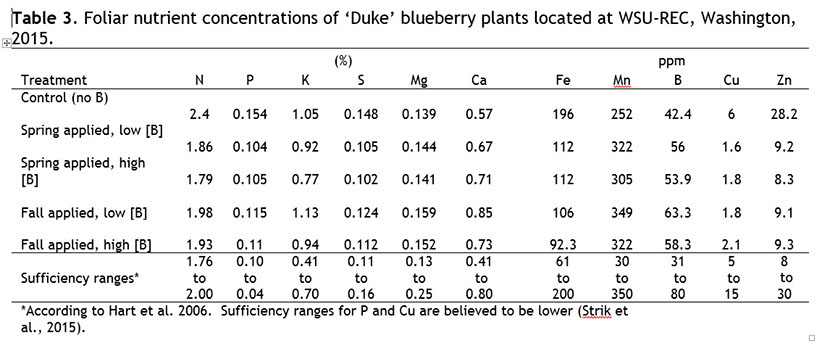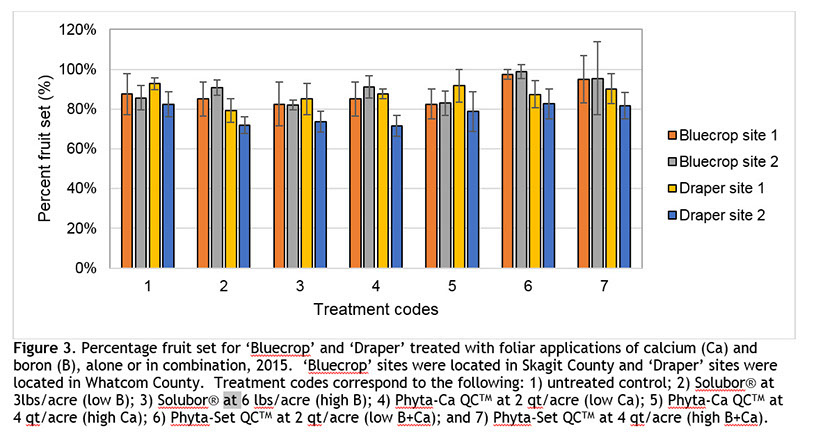Volume 5 Issue 7
Lisa Wasko DeVetter, WSU Small Fruit Horticulturist
Matthew Arrington, Ph.D. Graduate Student in Small Fruit Horticulture
Introduction
The main objective of this project is to test the hypothesis that foliar-applied boron (B) can increase fruit set and resultant yield of highbush blueberry (Vaccinium corymbosum). Specific sub-objectives are to: 1) evaluate the effects of foliar-applied B on measured yield components when applied at low or high rates in the spring or fall, and 2) measure the effects of B application on pollen germination, tube growth, and fertilization of ovules.
In 2014, we began this project with Experiment 1, which was conducted with established ‘Duke’ plants at the Washington State University Mount Vernon Research and Extension Center (WSU-REC). These plants were heavily infected with blueberry shock virus (BIShV) in 2015, which negatively impacted the collection of fruit set and yield data. As a result, we are unable to confidently draw conclusions from this year of the study for that particular experiment. In 2015, Mr. Matthew Arrington began his PhD program in DeVetter’s program and initiated a series of related trials that we are including in this progress report as Experiment 2. Further description about the two experiments are below.
Experiment 1
Established ‘Duke’ plants located at the WSU-REC were used for this experiment. Tissue samples were collected in Aug. 2014 and detected nutrient deficiencies were corrected, including B. Soil samples were also collected in Fall 2014. Results from the preliminary tissue and soil sampling are presented in Tables 1 and 2. Correcting deficiencies was an important first step to allow discernment of treatment effects from the potential effects of pre-existing deficiencies within the plants.
Treatments were applied to individual plots consisting of three plants per plot. A total of three blocks with treatments in a randomized order within a block provided the experimental design. A buffer of two plants from the perimeter of the planting and one plant in between adjacent plots was established. Five treatments were applied and varied based on rate and timing of B application. These treatments include: 1) untreated control (no additional B); 2) fall applied B at 8 oz/acre; 3) spring applied B at 8 oz/acre; 4) fall applied B at 32 oz/acre; and 5) spring applied B at 32 oz/acre. The foliar product used for the experiment was BioGro NUE Boron 10% (derived from boric acid). Fall and spring applications corresponded to postharvest/prior leaf senescence and prebloom, respectively. The first cycle of treatment applications began in the fall of 2014 and was carried through in the spring of 2015. Foliar nutrient, soil chemistry, fruit set, estimated yield, and fruit firmness data were collected and are presented below. We would like to note that this study occurred during an exceptionally warm and dry year, which likely influences our results. Mover, the high incidence of BIShV influences the quality of our data, as we had few treatment plants that were not impacted by BIShV. These factors should be taken into consideration when interpreting the data, as results from 2015 may not be applicable to the normal climactic conditions experienced in western Washington.
Foliar and soil test results are presented in Tables 3 and 4. Foliar samples collected across the treatments were within nutrient sufficiency ranges with the exception of sulfur (S) and copper (Cu) (Table 3). Plants treated in the spring with both high and low concentrations of B were slightly below the sufficiency range for S. We do not believe this difference is significant nor related to our treatments. All treated plants were below the sufficiency range for Cu. However, newly published research in Oregon is proposing to lower the sufficiency standards for this micronutrient (Strik and Vance, 2015). Furthermore, we did not observe any symptoms of Cu deficiency. Soil test results are presented in Table 4. There are differences between soil results from 2014 and 2015 (Tables 2 and 4). Many of these differences can be attributed to our fertility regime, which was newly implemented in 2014 (DeVetter’s research program was initiated in 2014). The most notable difference between the years is the increase in organic matter from 2014 to 2015. Sawdust mulch was applied in 2015 and is likely responsible for the increases in organic matter, particularly if sawdust mulch remained in the soil sample. In addition, we began sending our foliar and soil samples to be tested at a new lab (Brookside Laboratories, Inc.; New Bremen, OH) and differences in testing protocols may result in differences in our results between 2014 and 2015.
Percentage fruit set is presented in Fig. 1. Overall fruit set was greater than 60% for all treatments, with the exception of plants treated with B at a low concentration in the spring. Based on our observations in the field, the reduction in fruit set for plants in this treatment was due to high infection rates of BIShV, not treatments. Fruit set was greatest in the control treatment. Fruit set was on average greater in 2015 than in previous years, which is attributed to warmer weather that was more conducive for pollination and fruit set (Strik, 2004). Fig. 2 presents estimated yield, which is determined for each plant using the following equation:
Estimated yield = [average cane #] x [average # fruit clusters/cane] x [average # berries/cluster] x [average berry weight] x [0.0022062] = lbs/plant
The variables of “[average # fruit clusters/cane]” and “[average # berries/cluster]” were determined from two canes per bush
and two clusters per cane, respectively. Average berry weight was determined from a sample of 30 berries per treatment and replication. The value of 0.002205 is a conversion factor to allow data to be presented in pounds. Individual plant yields were low due to BIShV. Similar to the fruit set data, estimated yield was lowest for plants treated with low concentrations of B in the Spring. We again attribute this to plants in this treatment being the most severely impacted by BIShV. Estimated yields were otherwise similar across the treatments. Firmness was also assessed on harvested berries using a FirmTech 2 (Bio Works, Inc., Wamego, KS). No treatment differences were detected and firmness exceeded 200 g/mm deflection (data not presented). Pollen was collected in the spring, desiccated, and stored at -20 °C. Pollen viability tests will soon be underway according to the procedures outlined by Dogterom et al. (2000).






Experiment 2
This experiment is an expansion of Experiment 1 and was initiated in Spring of 2015, when graduate student Mr. Matt Arrington joined DeVetter’s program. Trials occurred in four commercial blueberry fields, with two in Skagit County and two in Whatcom County. Treatments were applied on established ‘Draper’ and ‘Bluecrop’ plants beginning at the “early pink bud” stage in 2015 and continued every 7 to 10 days for a total of six applications. Treatments included: 1) untreated control; 2) Solubor® (20.5% B as disodium octaborate tetrahydrate) at 3lbs/acre (low B); 3) Solubor ® at 6 lbs/acre (high B); 4) Phyta-Ca QCTM (8% Ca from calcium chloride) at 2 qt/acre (low B); 5) Phyta-Ca QCTM at 4 qt/acre (high B); 6) Phyta-Set QCTM (6% Ca from calcium chloride and 1% B from sodium tetraborate) at 2 qt/acre (low B+Ca); and 7) Phyta-Set QCTM at 4 qt/acre (high B+Ca). Products were applied according to their label rates. Inclusion of Ca in the experimental design allows us to study the effects of this nutrient on our measured variables, as well as the interaction of B and Ca, which may be particularly useful for cultivars that demonstrate premature fruit drop like ‘Draper’. Previous research led by Mr. Eric Gerbrandt (Associate Director of the Pacific Berry Resource Centre, BC, Canada) has suggested premature fruit drop in ‘Draper’ is due to a Ca deficiency.
Results from 2015 have been shared with grower cooperators in the form of an annual grower summary. Much like Experiment 1, few significant differences were observed and we attribute this to weather.
Soil samples collected in Spring 2015 confirmed soil nutrients were within recommended ranges (data not presented). There were no statistical differences in fruit set across the sites and percentage fruit set across all sites and cultivars averaged 86% (Fig. 3). Average fruit set across sites in ‘Bluecrop’ and ‘Draper’ was 89% and 83%, respectively. Although statistically insignificant, fruit set numerically increased with the Phyta-Set QCTM treatments that contained both B and Ca. This numeric increase in fruit set was most noticeable in ‘Bluecrop’. Estimated yield differed by grower site, but there were no treatment differences within a site regardless of cultivar (Fig. 4). Differences in estimated yield across sites is attributed to differences in plant size and corresponding productivity. Fruit firmness was evaluated and there were no differences across treatments (data not presented).
Foliar tissue analyses indicated that there were no significant differences between nutrient concentrations of untreated and treated plants (Figs. 5 and 6). However, fruit tissue analyses of harvested berries showed up to 60% more B in fruit from plants treated with the high B treatment (Fig. 5). Increases in fruit Ca concentrations were modest, being raised by as much as 22% in plants treated with the higher concentration of Ca and with an average increase of ~7% across all sites (Fig. 6). We also observed cultivar differences, namely ‘Bluecrop’ appeared more sensitive to B applications than ‘Draper’, as exhibited by elevated B concentrations in foliar tissue samples (Fig. 5). However, ‘Draper’ berries from Site 1 also had high concentrations of B. Despite the promising increase of B and Ca in fruit tissue nutrient concentrations, which demonstrates that some of these applied nutrients were being taken up by the plant, it remains to be determined if foliar supplementation with B and Ca under more typical and marginal climatic conditions during the bloom time will increase overall fruit set, yield, and attributes of berry quality. Further trials in 2016 will help clarify the impacts of foliar B and Ca treatments on our variables of interest.
Results from 2015 and prevailing weather conditions also inform us more about the premature fruit drop disorder periodically observed in ‘Draper’ grown in western Washington. No fruit drop was observed across treatments and locations in 2015. Furthermore, very little premature fruit drop was observed in western Washington in 2015. While the lack of fruit drop in ‘Draper’ may be due to increased commercial applications of Ca, which has been suggested to mitigate fruit drop symptoms, the fact that we observed no fruit drop in our control treatments (i.e., untreated) indicates that this disorder may not be solely influenced by Ca. Research led by Mr. Gerbrandt and others is ongoing and it’s important to continue studying the effects of Ca on fruit drop and other fruit quality attributes of blueberry, but there is preliminary evidence that fruit drop in ‘Draper’ may be partially due to environmental effects.




References
- Dogterom, M.H., M.L. Winston, A. Mukai. 2000. Effect of pollen load size and source (self, outcross) on seed and fruit production in highbush blueberry cv. ‘Bluecrop’ (Vaccinium corymbosum; Ericaceae). American Journal of Botany 87:1584-1591.
- Hart, J., B. Strik, L. White, and W. Yang. 2006. Nutrient management for blueberries in Oregon. Oregon State University Extension Service. EM 8918.
- Strik, B. 2004. Blueberry production and research trends in North America. In VIII International Symposium on Vaccinium Culture 715: 173-184.
- Strik, B. and A.J. Vance. 2015. Seasonal variation in leaf nutrient concentration of northern highbush blueberry cultivars grown in conventional and organic production systems. HortScience 50(10): 1453-1466.
Acknowledgements
We would like to thank our grower cooperators, who make this work possible. Additionally, we are grateful for the funding from the Washington Blueberry Commission. Additional thanks go to Dr. Lee Kalcits (WSU Tree Fruit Physiologist), Mr. Sean Watkinson (SFH Technician), Rachel Weber, and Eric Gerbrandt for project assistance.